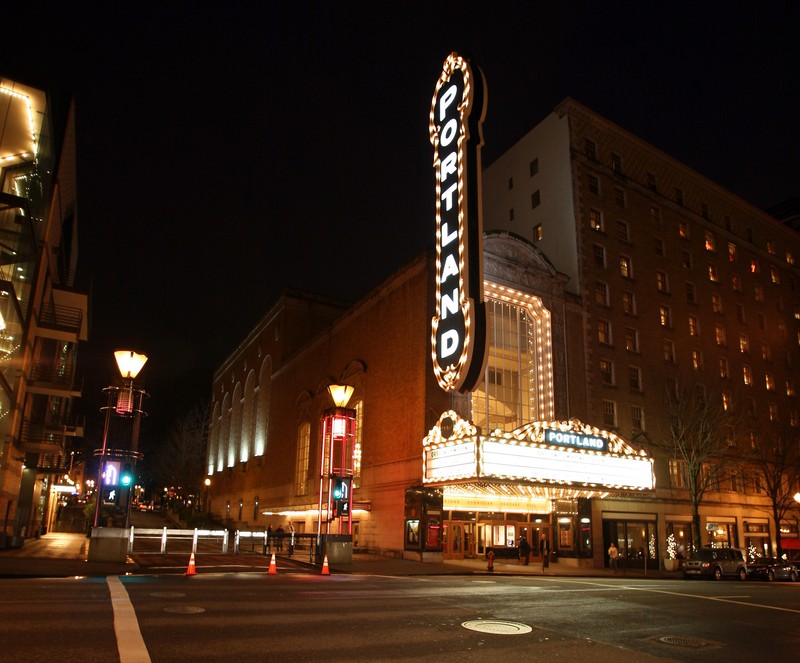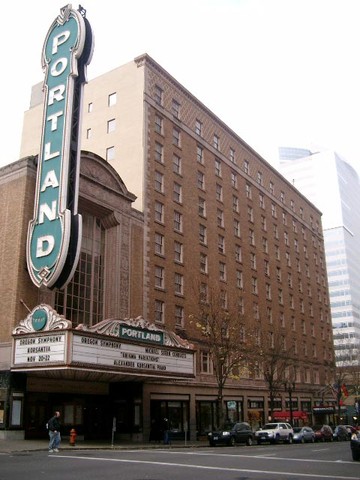Arlene Schnitzer Concert Hall (a.k.a. Portland Publix Theater and Paramount Theatre).
Introduction
Text-to-speech Audio
This movie theater opened in 1928 at a time when theaters lined Broadway street. Chicago's architectural firm, Rapp & Rapp, designed this theater and nearly 400 other theaters and movie palaces across the nation during the early 20th century. Today, the historic structure is known as Arlene Schnitzer Concert Hall.
The building opened in 1928 as a vaudeville venue, named the Portland Publix Theatre. Two years later the building name changed to the Paramount Theater when the owners reached an agreement with Paramount films to run their movies exclusively. Affectionately referred to as the Schnitz by locals; it stands as a reminder of the Roaring Twenties, a time of economic prosperity, a transition from a rural nation to one dominated by cities, increased leisure time for the white middle class and the influence of Hollywood on American culture.
Images
Constructed as a movie palace in 1928, this historic structure is now home to the Arlene Schnitzer Concert Hall.

The theater was saved from demolition in the early 1970s.

Backstory and Context
Text-to-speech Audio
Similar to other major cities, Portland was home to an ornate movie palace designed by Chicago's Rapp & Rapp. This theater company once held nearly 400 theaters across the nation. The interwar period for the U.S. coincided with the eventual "roaring twenties," which included a move from vaudeville and nickelodeons to movies -- and opulent movie houses arrived in almost every major city as a result. The "Schniz" opened its doors in 1928.
The theater boom began during World War I as motion pictures grew in popularity as an accepted art form. Nickelodeons had catered to busy workers with little means to spend on luxury items. As well, movies were not highly regarded by the middle and upper classes, as they continued to enjoy live theater productions. During World War I, and especially during the Interwar Period, movies received better favor from affluent Americans. Thus, the places that showed the films needed to reflect the needs and desires of those with money to spend, a more common occurrence during the economic growth o of the Roaring Twenties; more than 4,000 movie palaces opened from 1914-1922 alone.
Like many movie palaces that arose during the Interwar Period in America, the Paramount enjoyed a rich design filled with plenty of luxuries. From French-paned windows, crystal chandeliers, and velvet drapes to grand pianos, artwork, marble floors and high-end carpeting; the intricate details were likely awe-inspiring to those entering the facility. The theater also boasted of its exceptionally large candy counter and two lounges, both with paid attendants -- one for men, one for women. Men took advantage of its fireplaces, telephones, radios, and phonographs while women were able to use dressing tables, mirrors, maids, and hairdressers.
The theatre weathered the Great Depression by employing a wide variety of sales gimmicks, such as employing roving musicians and hiring psychics to perform or provide services. During World War II, war bonds were sold at special shows. After World War II, the middle class steadily moved to suburban communities, and television grew immensely popular, leaving movie palaces without many customers.
The Portland theater remained functional through the 1960s, but the palace almost met its demise in 1971 when John Haviland, owner of the Park Haviland Hotel, sought to purchase the block of which the theater sits and promptly demolish it. Public outcry prevented him from moving forward with the demolition. Thus, he leased the hall to a company that specialized in hosting Rock concerts during the 1970s. Famous '70s musicians and bands such as Heart, Tom Petty, and Elvis Costello, played there, but Haviland felt the rent was far too cheap and, instead, proposed to turn the theater into a casino.
He claimed that he was losing money on the property, notably because, he felt, the youth attending rock concerts did not spend money within the theater. So, in March 1975, Haviland sold the pipe organ, antique furniture, 16th century suit of armor, mirrors, China, Oriental rugs, original oil paintings, lighted gold-leaf music stands, and three grand pianos. Over the course of the next decade, the theater changed hands, fell into disrepair, and eventually the city condemned the building in 1982. A condemnation hearing jury determined that Portland had to pay the owner $4.1 million as compensation for the building; The theater cost $500,000 to build in 1928, but by 2006 had been assessed at more than $32,000,000.00.
By 1984, the building received a large facelift and renovation, turning it into the music venue that remains in place today. When the performing arts center was opened in 1984, the name changed to the Portland Theatre building after Arlene Schnitzer.
Sources
Fitzgibbon, Joe. Portland Paramount Theatre/Arlene Schnitzer Concert Hall. The Oregon Encyclopedia. June 13, 2017.
https://oregonencyclopedia.org/articles/portland_paramount_theatre_arlene_schnitzer_concert_hall/#.W....
Hartwig, Paul B. National Register of HIstoric Places Nomination Form. National Parks Service. Accessed June 19, 2017. https://npgallery.nps.gov/GetAsset/cd488f90-de34-4e16-bf17-98dbba9e25f8/.
Slowinska, Maria A. "Consuming Illusion, Illusions of Consumability: American Movie Palaces of the 1920s." Amerikastudien / American Studies 50, no. 4 (2005): 575-601. http://www.jstor.org/stable/41158182.
Image One by user:Cacophony - Own work, CC BY-SA 2.5, https://commons.wikimedia.org/w/index.php?curid=1714505
Image Two by Ajbenj at English Wikipedia - Transferred from en.wikipedia to Commons., Public Domain, https://commons.wikimedia.org/w/index.php?curid=1855086
https://oregonencyclopedia.org/articles/portland_paramount_theatre_arlene_schnitzer_concert_hall/#.W....
Hartwig, Paul B. National Register of HIstoric Places Nomination Form. National Parks Service. Accessed June 19, 2017. https://npgallery.nps.gov/GetAsset/cd488f90-de34-4e16-bf17-98dbba9e25f8/.
Slowinska, Maria A. "Consuming Illusion, Illusions of Consumability: American Movie Palaces of the 1920s." Amerikastudien / American Studies 50, no. 4 (2005): 575-601. http://www.jstor.org/stable/41158182.
Image One by user:Cacophony - Own work, CC BY-SA 2.5, https://commons.wikimedia.org/w/index.php?curid=1714505
Image Two by Ajbenj at English Wikipedia - Transferred from en.wikipedia to Commons., Public Domain, https://commons.wikimedia.org/w/index.php?curid=1855086
